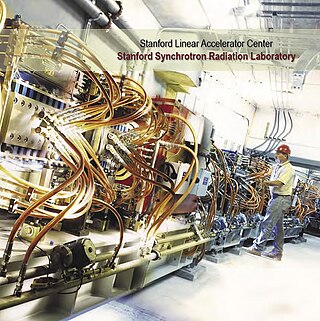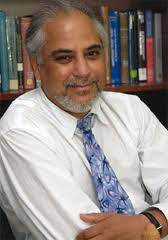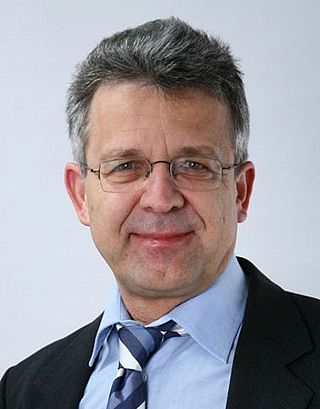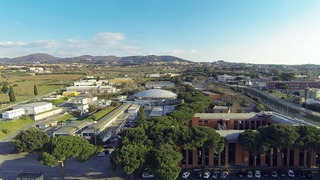Related Research Articles

DESY, short for Deutsches Elektronen-Synchrotron, is a national research centre for fundamental science located in Hamburg and Zeuthen near Berlin in Germany. It operates particle accelerators used to investigate the structure, dynamics and function of matter, and conducts a broad spectrum of interdisciplinary scientific research in four main areas: particle and high energy physics; photon science; astroparticle physics; and the development, construction and operation of particle accelerators. Its name refers to its first project, an electron synchrotron. DESY is publicly financed by the Federal Republic of Germany and the Federal States of Hamburg and Brandenburg and is a member of the Helmholtz Association.

SLAC National Accelerator Laboratory, originally named the Stanford Linear Accelerator Center, is a federally funded research and development center in Menlo Park, California, United States. Founded in 1962, the laboratory is now sponsored by the United States Department of Energy and administrated by Stanford University. It is the site of the Stanford Linear Accelerator, a 3.2 kilometer (2-mile) linear accelerator constructed in 1966 that could accelerate electrons to energies of 50 GeV.

Burton Richter was an American physicist. He led the Stanford Linear Accelerator Center (SLAC) team which co-discovered the J/ψ meson in 1974, alongside the Brookhaven National Laboratory (BNL) team led by Samuel Ting for which they won Nobel Prize for Physics in 1976. This discovery was part of the November Revolution of particle physics. He was the SLAC director from 1984 to 1999.

A free-electron laser (FEL) is a fourth generation light source producing extremely brilliant and short pulses of radiation. An FEL functions much as a laser but employs relativistic electrons as a gain medium instead of using stimulated emission from atomic or molecular excitations. In an FEL, a bunch of electrons passes through a magnetic structure called an undulator or wiggler to generate radiation, which re-interacts with the electrons to make them emit coherently, exponentially increasing its intensity.

The Kavli Institute for Particle Astrophysics and Cosmology (KIPAC) is an independent joint laboratory of Stanford University and the SLAC National Accelerator Laboratory, founded in 2003 by a gift by Fred Kavli and The Kavli Foundation. It is housed on the grounds of the SLAC National Accelerator Laboratory, as well as on the main Stanford campus. It is one of 20 Kavli Institutes.

The Stanford Synchrotron Radiation Lightsource, a division of SLAC National Accelerator Laboratory, is operated by Stanford University for the Department of Energy. SSRL is a National User Facility which provides synchrotron radiation, a name given to electromagnetic radiation in the x-ray, ultraviolet, visible and infrared realms produced by electrons circulating in a storage ring at nearly the speed of light. The extremely bright light that is produced can be used to investigate various forms of matter ranging from objects of atomic and molecular size to man-made materials with unusual properties. The obtained information and knowledge is of great value to society, with impact in areas such as the environment, future technologies, health, biology, basic research, and education.

Electron scattering occurs when electrons are displaced from their original trajectory. This is due to the electrostatic forces within matter interaction or, if an external magnetic field is present, the electron may be deflected by the Lorentz force. This scattering typically happens with solids such as metals, semiconductors and insulators; and is a limiting factor in integrated circuits and transistors.
SPEAR[a] was a collider at the SLAC National Accelerator Laboratory. It began running in 1972, colliding electrons and positrons with an energy of 3 GeV. During the 1970s, experiments at the accelerator played a key role in particle physics research, including the discovery of the
J/ψ
meson, many charmonium states, and the discovery of the tau.
Joachim Stöhr is a physicist and professor emeritus of the Photon Science Department of Stanford University. His research has focused on the development of X-ray and synchrotron radiation techniques and their applications in different scientific fields with emphasis on surface science and magnetism. During his career he also held several scientific leadership positions, such as the director of the Stanford Synchrotron Radiation Laboratory (SSRL) and he was the founding director of the Linac Coherent Light Source (LCLS), the world's first x-ray free electron laser.

Swapan Chattopadhyay CorrFRSE is an Indian American physicist. Chattopadhyay completed his PhD from the University of California (Berkeley) in 1982.

A particle accelerator is a machine that uses electromagnetic fields to propel charged particles to very high speeds and energies to contain them in well-defined beams. Small accelerators are used for fundamental research in particle physics. Accelerators are also used as synchrotron light sources for the study of condensed matter physics. Smaller particle accelerators are used in a wide variety of applications, including particle therapy for oncological purposes, radioisotope production for medical diagnostics, ion implanters for the manufacturing of semiconductors, and accelerator mass spectrometers for measurements of rare isotopes such as radiocarbon.
Stanford University has many centers and institutes dedicated to the study of various specific topics. These centers and institutes may be within a department, within a school but across departments, an independent laboratory, institute or center reporting directly to the dean of research and outside any school, or semi-independent of the university itself.
Ultrafast X-rays or ultrashort X-ray pulses are femtosecond x-ray pulses with wavelengths occurring at interatomic distances. This beam uses the X-ray's inherent abilities to interact at the level of atomic nuclei and core electrons. This ability combined with the shorter pulses at 30 femtosecond could capture the change in position of atoms, or molecules during phase transitions, chemical reactions, and other transient processes in physics, chemistry, and biology.

Martin Aeschlimann is a Swiss physicist and professor in the physics department of the University of Kaiserslautern. Since 2008 he is the spokesman of the State Research Center for Optics and Material Sciences (OPTIMAS).

Philip H. Bucksbaum is an American atomic physicist, the Marguerite Blake Wilbur Professor in Natural Science in the Departments of Physics, Applied Physics, and Photon Science at Stanford University and the SLAC National Accelerator Laboratory. He also directs the Stanford PULSE Institute.

The INFN National Laboratory of Frascati (LNF) was founded in 1954 with the objective of furthering particle physics research, and more specifically to host the 1.1 GeV electrosynchrotron, the first accelerator ever built in Italy. The Laboratory later developed the first ever electron-positron collider: from the first prototype AdA, which demonstrated the feasibility, to the ring ADONE and later on to DAΦNE, still operative today (2024). LNF was also the proposed site of the cancelled particle accelerator SuperB.

Claudio Pellegrini is an Italian/American physics and emeritus professor at University of California, Los Angeles (UCLA), known for his pioneering work on X-ray free electron lasers and collective effects in relativistic particle beams.

Janos Hajdu is a Swedish/Hungarian scientist, who has made contributions to biochemistry, biophysics, and the science of X-ray free-electron lasers. He is a professor of molecular biophysics at Uppsala University and a leading scientist at the European Extreme Light Infrastructure ERIC in Prague.
Sergio Carbajo is a Basque-Spanish-American scientist and educator, musician and composer, and creative writer. He is an assistant professor at the University of California, Los Angeles Samueli School of Engineering and Applied Sciences with appointments in the Electrical & Computer Engineering (ECE) and Physics & Astronomy departments. He is also a scientist at Stanford University’s Photon Science Division at SLAC National Accelerator Laboratory.
Nina Rohringer is an Austrian physicist whose research concerns ultra-fast pulses from free-electron X-ray lasers, and their interactions with matter. She is a lead scientist at DESY, a professor at the University of Hamburg, and a faculty member of the Max Planck Institute for the Structure and Dynamics of Matter, in Germany.
References
- ↑ Interdisciplinary Laboratories, Centers, and Institutes. N.p., n.d. Web. 31 May 2013. <https://doresearch.stanford.edu/research-scholarship/interdisciplinary-laboratories-centers-and-institutes>.
- ↑ Sharon Simonson (November 6, 2005). "Stanford Moves on $400 Million Laser Project". Silicon Valley/San Jose Business Journal. Retrieved June 13, 2013.
- ↑ Controlling the Quantum World: The Science of Atoms, Molecules, and Photons. Washington, D.C.: National Academies, 2007, p.225. Print.
- ↑ "New Life for Old Electrons in Biological Imaging, Sensing Technologies". Nanowerk News. November 8, 2011. Retrieved June 13, 2013.
- ↑ Torrice, Michael. "Watching Electrons with Lasers." SLAC Today. N.p., Nov. 2008. Web. 01 June 2013. <http://today.slac.stanford.edu/feature/2008/hhg.asp>.
- ↑ Gewin, Virginia. "Philip Bucksbaum, Director, Stanford Ultrafast Science Center, Stanford, California." Nature 439.7074 (2006): 366. Print.
- ↑ "David Reis named head of PULSE Institute for ultrafast science". SLAC National Accelerator Laboratory. Retrieved 2021-06-16.